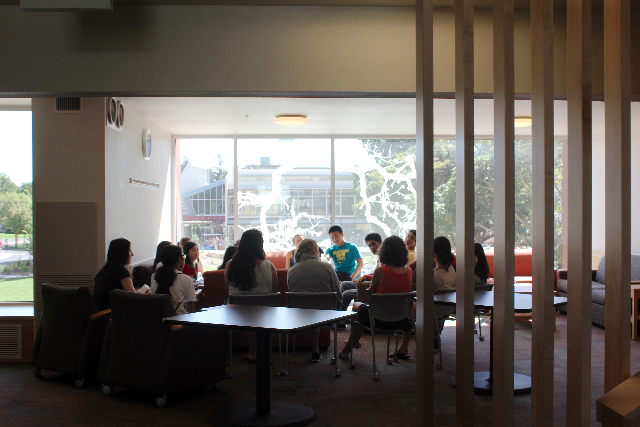This year, UC Davis Dining Services and Student Housing will implement new dining commons policies regarding guest meals and take-out food, amongst other changes to the three dining areas on campus, for all students with meal plans.
In response to these changes, a discussion was launched on the Facebook group titled “Sell/Buy DC Swipes” at the end of the 2013-2014 school year.
The biggest change to dining commons policies this year, fueling the online forum, is a new limit on “guest” swipes available to students who purchase a meal plan.
“We will be limiting the number of guest swipes, a swipe that allows a student to bring in an outside guest, to 10,” said Office of Student Development Director Branden Pettit in an email interview.
Many students with meal plans that have been known to swipe others in are involved with larger on-campus organizations. Pettit explained that the limit was placed to protect these students from being pressured by their peers from clubs, sports teams and other extracurricular activities to swipe in groups.
However, the limit is a blow to online exchange groups like “Sell/Buy DC Swipes” which relied on previous policies allowing students to swipe in guests as often as they wanted.
“A year ago, freshmen could sell their swipes to other students, particularly upperclassmen and graduate students, if they had any leftover swipes at the end of their last quarter as freshmen,” said second-year design major Rachel Kreager. “Those students were then able to get the swipes at a much lower price than what [they normally cost]. This not only helps the freshmen get a few bucks back, but also lets [other] students eat and save money.”
The “Sell/Buy DC Swipes” page was made to facilitate the exchange of swipes into the DC, encouraging freshmen to use swipes that would otherwise go to waste under the policies at the time. The group was still active over the summer, with students offering to sell swipes for $5 each.
Kreager began the discussion on the online group by posting an image that detailed the changes to meal plans for the 2014-2015 school year. The post is currently pinned at the top of the page.
“Bottom line, it is our money; we should be able to use it how we want,” Kreager said.
Last year, students did not have the option to cash out their swipes at the end of the year in exchange for Aggie Cash. Instead, students were expected to choose the meal plan that best fit their needs.
“Our hope was to encourage students to adjust to the best meal plan each quarter with the goal of ‘zeroing out’ at the end of the year,” said UC Davis Food Service Contract Manager Kraig Brady in an email interview. “This would be the absolute best value for the students. While this was successful for many students, it was challenging for those who did not have the time to make the adjustments.”
Those who did not make the swipe adjustment found that selling their swipes was a better option than losing them completely at the end of the year.
“Over this last year, since end-of-year rollover meals were not allowed, students were selling their swipes for $1 to $3 when they actually paid over $9 per swipe at the beginning of the quarter,” Pettit said. “This was a significant loss to students and very unfortunate.”
To avoid this loss, students can choose to donate their leftover swipes to the Swipe Out Hunger Fund, which includes various programs that help feed other students and Yolo County residents, including the UC Davis Food Pantry, Yolo County Food Bank, and the Aggie Meal Share program.
Additionally, Pettit said that the new policies allow students to cash out their swipes at the end of the year, specifically for $3 in Aggie Cash per swipe. The cost of keeping the DC up and running is the $6 which is not returned to the students as Aggie Cash.
“The $9 covers all the business costs to provide meal service, such as overhead, labor, food and facilities expenses,” Brady said. “$3 is the food cost portion of the expenses that will be converted at the end of the Spring Quarter. The remaining $6 covers the current fixed expense to run the Dining Commons.”
Although swipes can be converted to Aggie Cash at the end of the year, Kreager said it is not as useful as it was before the change.
“Aggie Cash is no longer available to use in off-campus restaurants,” Kreager said. “If freshmen are allowed to switch their leftover meals at the end of the quarter for a minimal amount of Aggie Cash, there should be more options on how they can spend it.”
However, even with fewer options, Aggie Cash offers students a discount at various locations.
“Aggie Cash still offers a 10 percent discount when dining at a Dining Service’s retail locations and is accepted at numerous retail locations throughout campus,” Brady said. “There is also no sales tax when using Aggie Cash for a residence hall student on a Student Housing meal plan. This is almost a 17.5 percent savings for students using Aggie Cash rather than using cash out of pocket.”
Two years ago, meal plans were changed to include a minimum of $100 of Aggie Cash per quarter. Brady said this minimum did not increase the cost of the meal plan and that students have until they graduate to spend all of their Aggie Cash.
In addition to these changes, Pettit said there will also be more options to use up swipes and avoid converting them to Aggie Cash through the new “DC to Go” option, allowing students a limited time to fill up and take out a food container for one swipe.
“The ‘DC to Go’ option is to provide our guests with a balanced meal, just like they would receive if they were to dine in the DC, with a ‘to go’ convenience,” Brady said. “The container is compartmentalized to hold an ample amount of food choices to compose a balanced meal. The ‘DC to Go’ option is not intended for our guests to load up on one specific item, say all of the chocolate chip cookies. Our service cashiers will help communicate these limitations.”
Beyond the addition of “DC to Go,” there are a few more changes coming specifically to the Tercero dining area.
“Running Monday through Thursday outside the grassy area of the Tercero DC, we will be offering an alternative service that will include either a BBQ menu or a food truck option,” Brady said. “Additionally, at the Tercero DC, we will not be closing the DC between dinner and late night service. Students will have more flexibility when they eat their evening meal.”
There is also an option which allows students to purchase up to $5 worth of food from vendors on campus with a swipe.
Brady said the changes to meal plans are meant to offer greater flexibility and convenience to students.
“We are always looking at our meal options to create the greatest value for our students,” Brady said. “Meal plans could and will adjust annually as conditions change.”





[…] University Dining Services regulates meal plan sharing This year, UC Davis Dining Services and Student Housing will implement new dining commons policies regarding guest meals and take-out food, amongst other changes to the three dining areas on campus, for all students with meal plans. In response to … Read more on The Aggie […]
[…] food, amongst other changes to the three dining areas on campus, for all students with meal plans, reports the Aggie campus paper. In response to these changes, a discussion was launched on a Facebook group […]